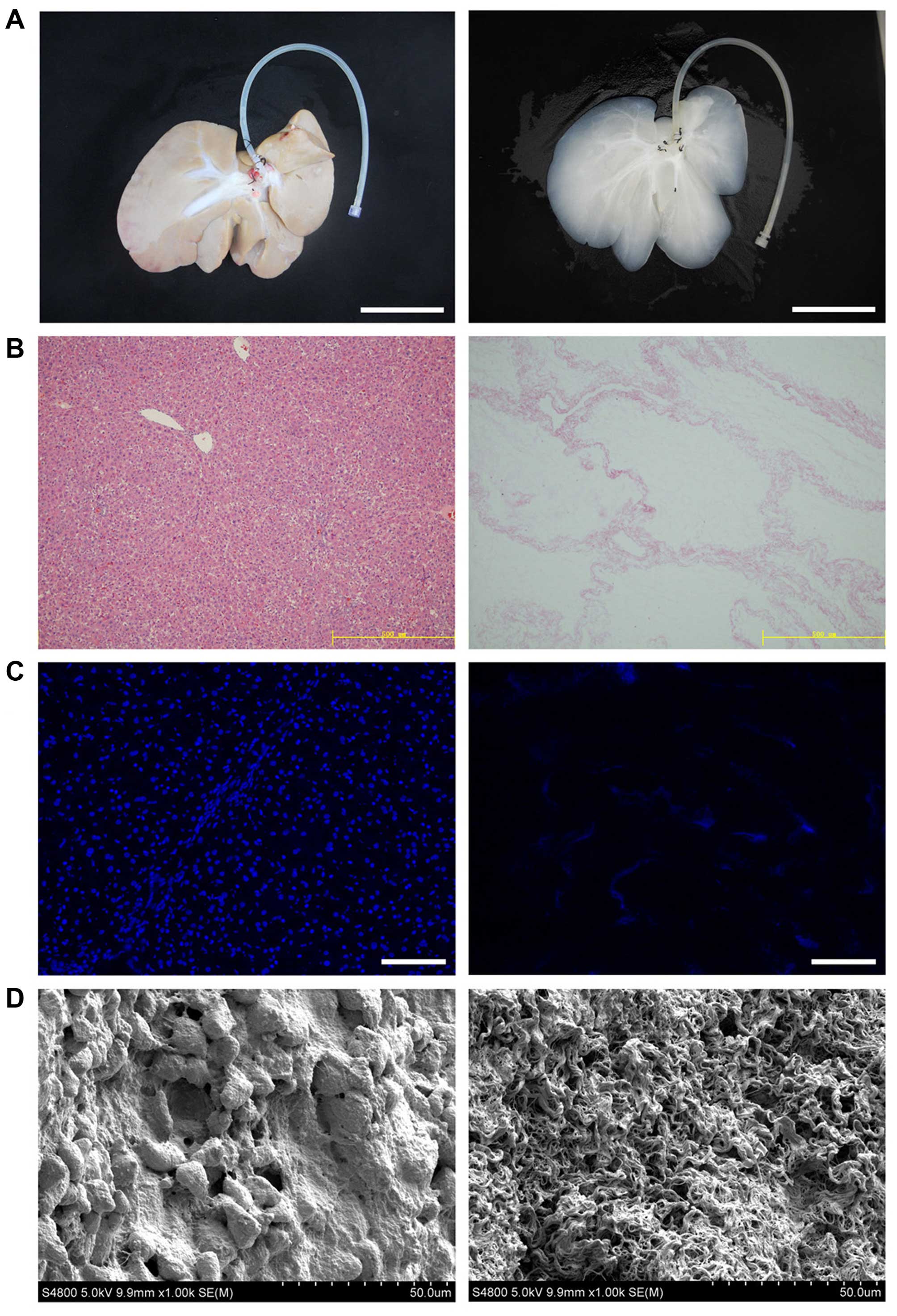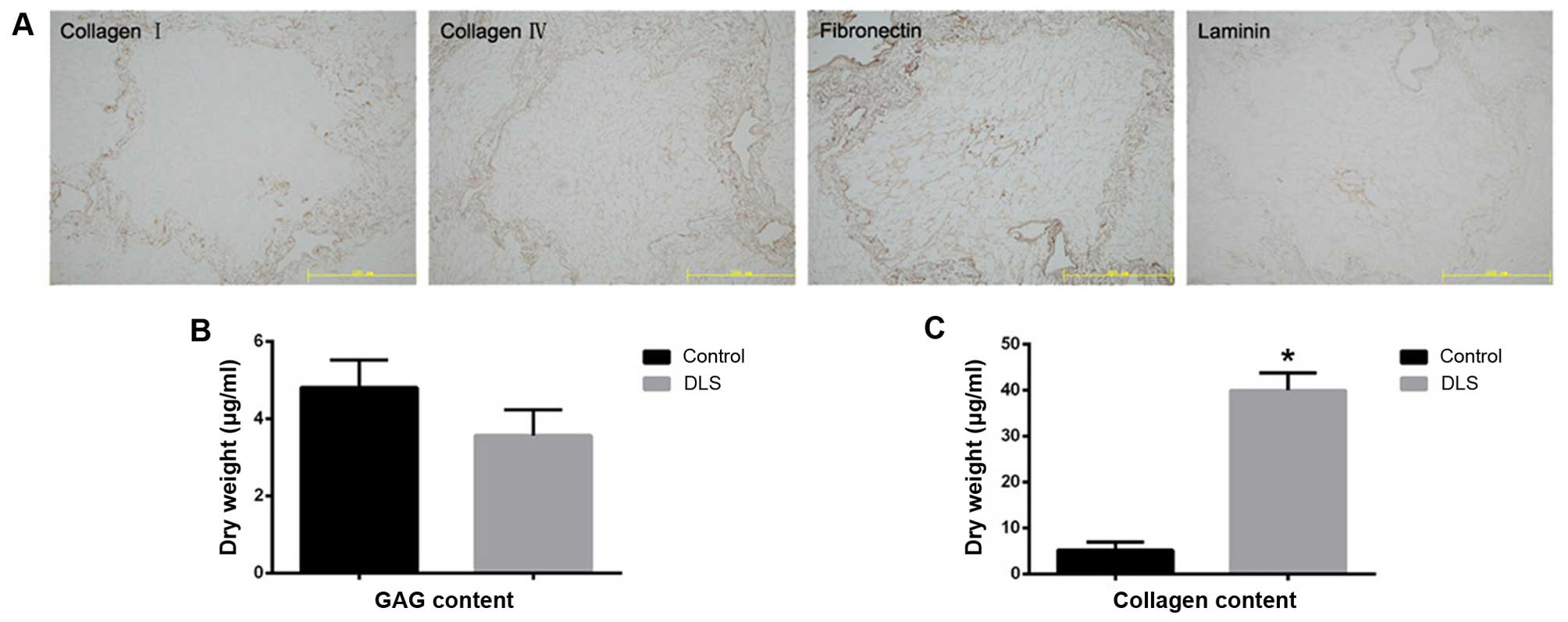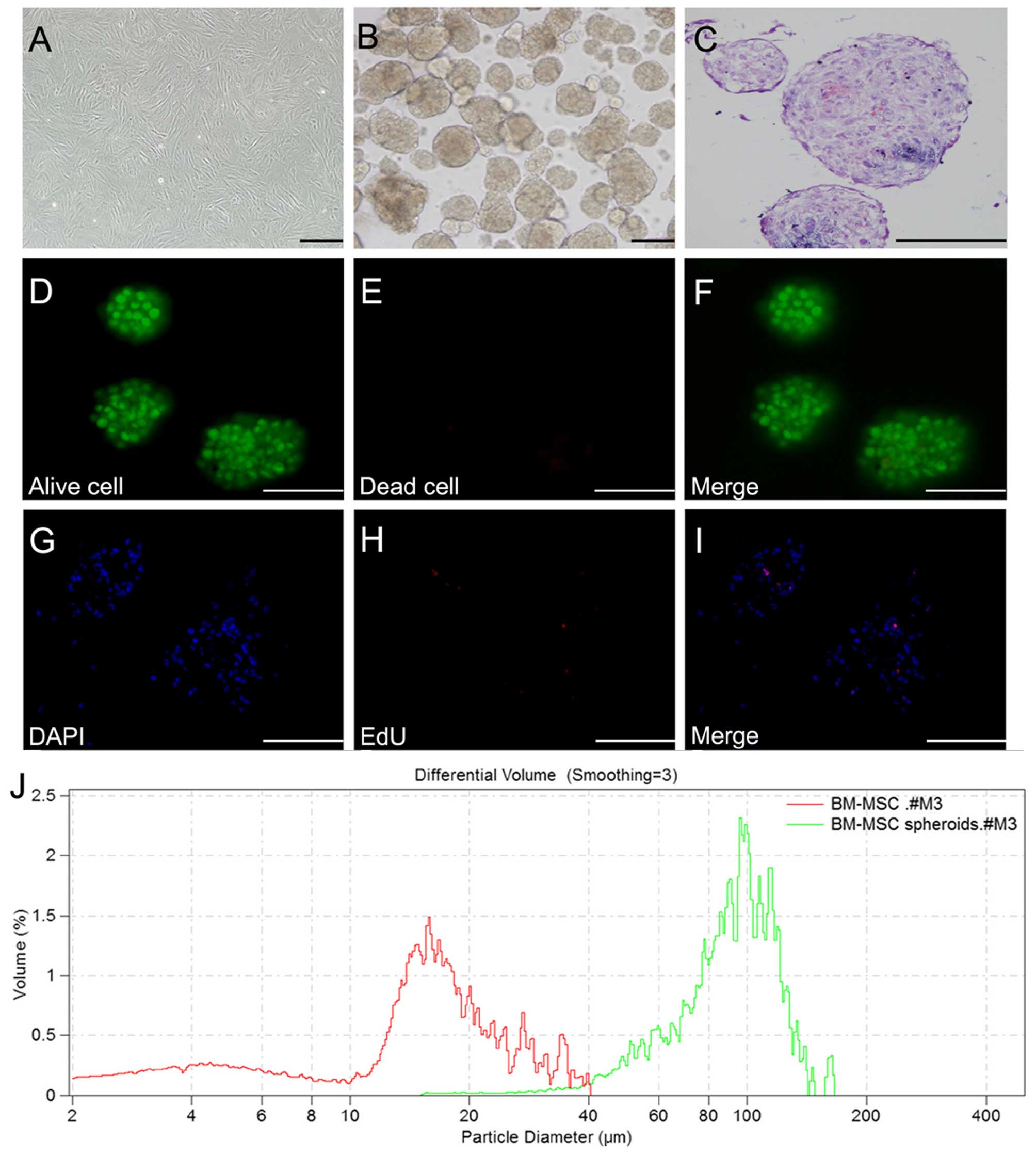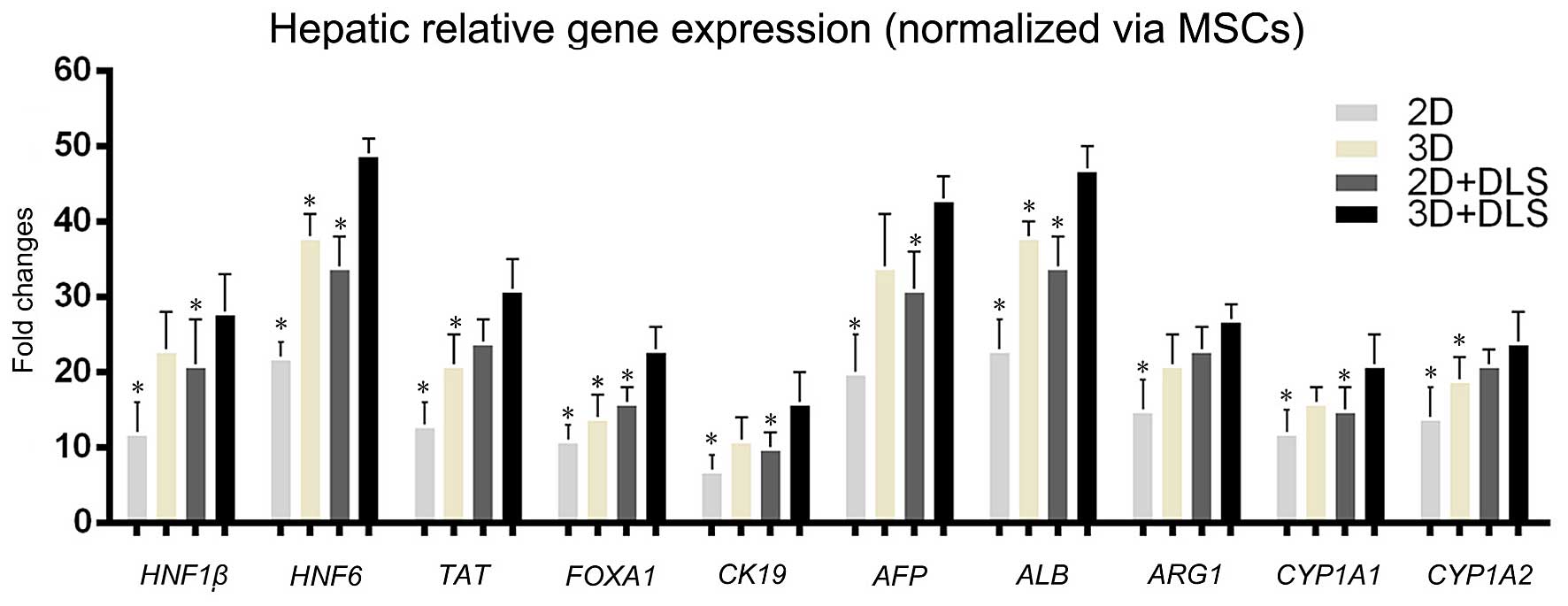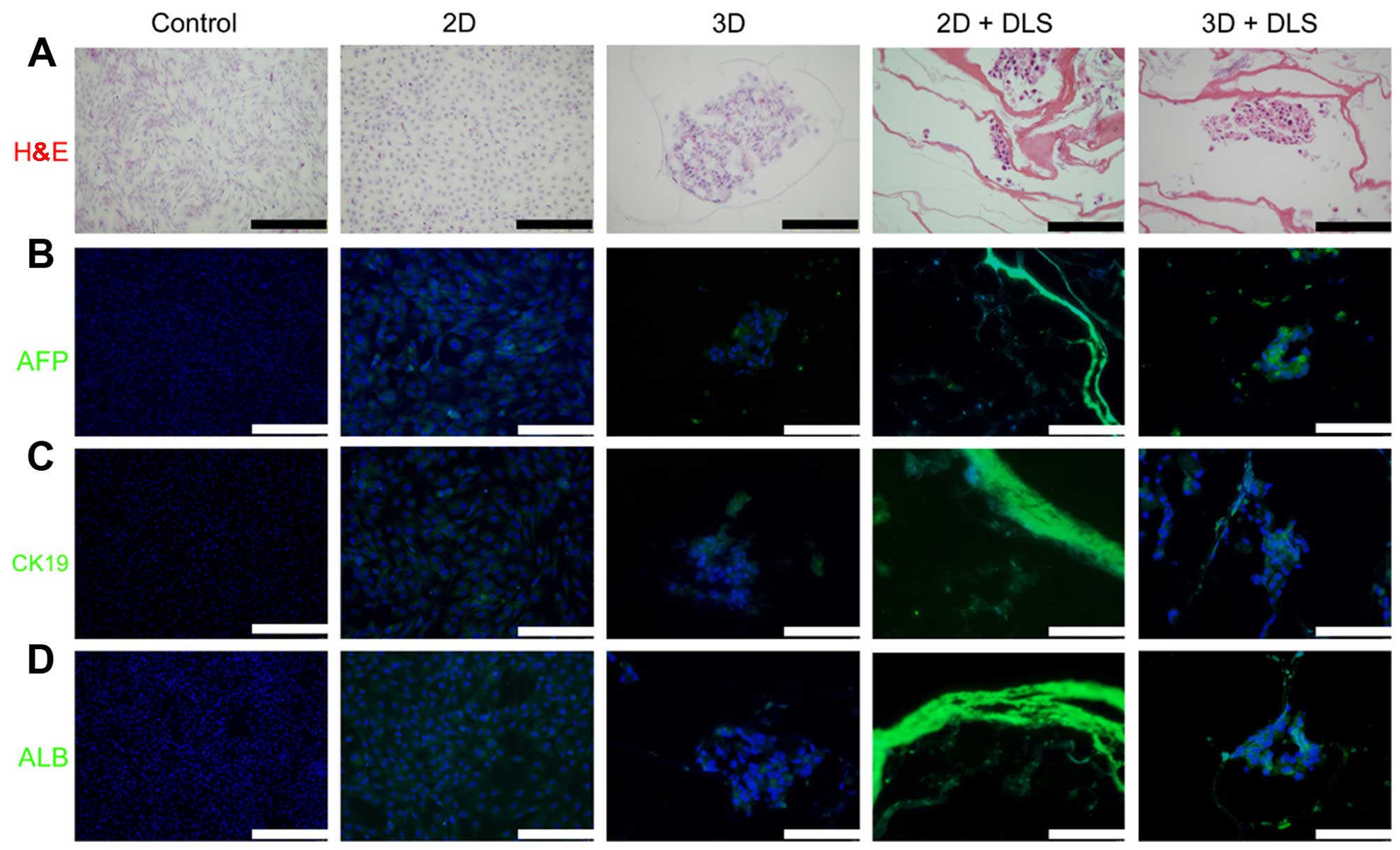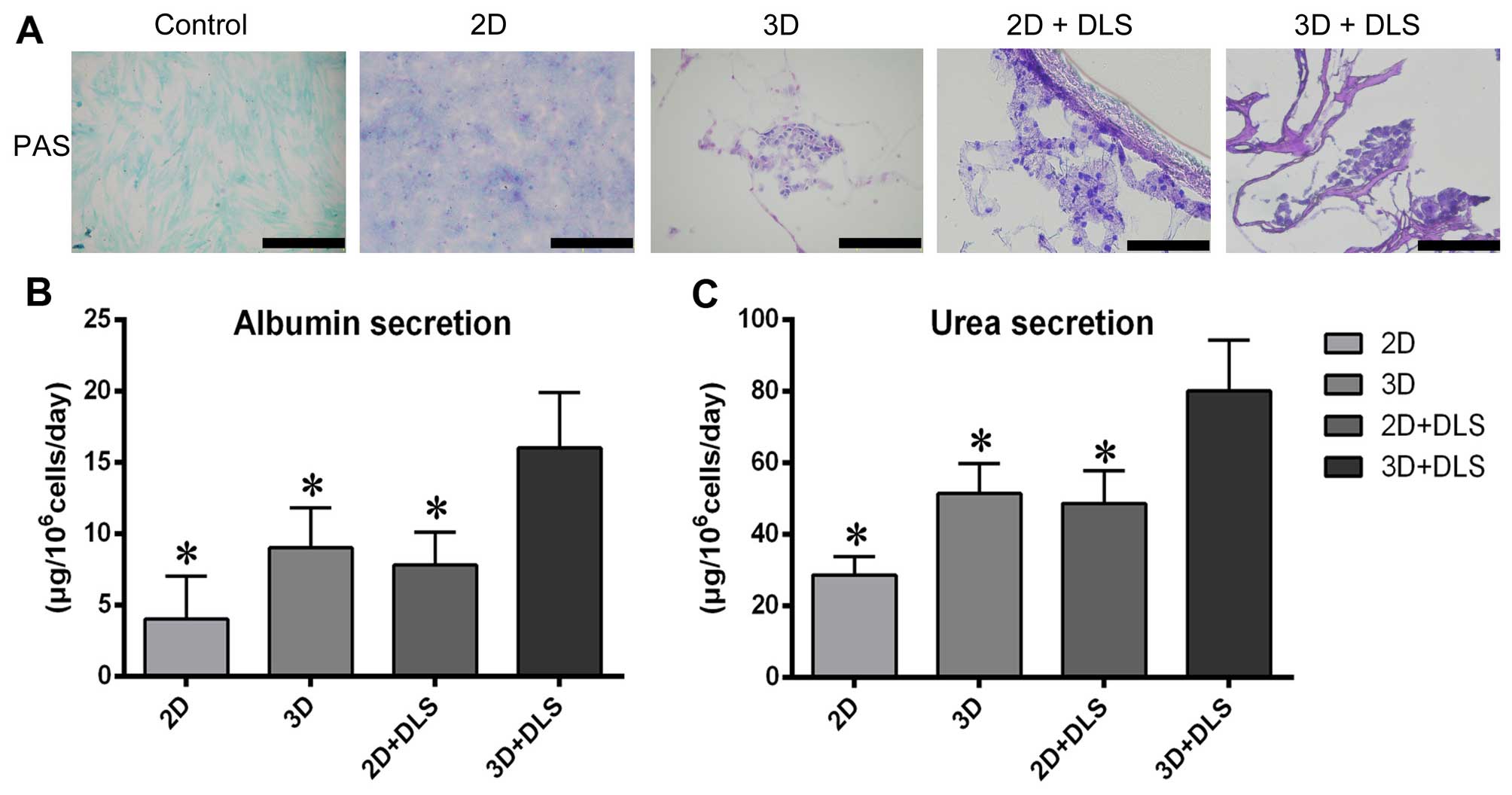Enhanced hepatic differentiation of rat bone marrow-derived mesenchymal stem cells in spheroidal aggregate culture on a decellularized liver scaffold
- Authors:
- Published online on: June 14, 2016 https://doi.org/10.3892/ijmm.2016.2638
- Pages: 457-465
-
Copyright: © Bao et al. This is an open access article distributed under the terms of Creative Commons Attribution License.
Abstract
Introduction
Orthotopic liver transplantation is the only currently available treatment for severe liver failure; however, the use of this technique is limited by organ shortages (1). Hepatocyte transplantation has become an attractive alternative approach to treating liver diseases (2). However, the isolation of sufficient numbers of transplantable hepatocytes is restricted by the small number of marginal donor organs (3). In addition, adult human hepatocytes have poor proliferative potential that is likely to be insufficient for effectively repopulating the host liver (4). The search for greater cell resources, which may be used to replace primary hepatocytes, has prompted investigations into the generation of hepatocytes from stem cells of extrahepatic origin, owing to their ready availability and unrestricted ability to propagate and differentiate (5). Mesenchymal stem cells (MSCs), which are found in various tissues and organs, have become an important resource for regenerative medicine, as they are readily available cells that proliferate in vitro and have the capacity for multiple lineage differentiation (6). Previous studies using rats, mice and humans have confirmed that bone marrow-derived MSCs (BM-MSCs) as well as MSCs derived from umbilical cord blood or adipose tissue may differentiate into hepatocyte-like cells under selective growth conditions in vitro, which suggests that adult stem cell-based therapies may provide alternative therapeutic approaches for the treatment of liver diseases (7–9).
Considerable efforts over the last decade have been dedicated to the evaluation of culture conditions in order to obtain differentiated hepatocytes from stem cells. The sequential addition of liver-specific factors into culture systems in a time-dependent manner that mimics the secretion pattern during liver embryogenesis is important for the differentiation of stem cells into hepatocytes (10). Advances in induction technology have enabled the in vitro differentiation of MSCs into hepatocyte-like cells using a two-dimensional (2D) culture system (11). However, the 2D culture method has limitations in terms of controlling stem cell differentiation pathways, resulting in low differentiation efficiency. Three-dimensional (3D) culture systems have been shown to promote enhanced cellular structure and function in many types of cells and tissues, including mammary epithelial cells, MSCs as well as neural and hepatic cells (12–14). MSCs cultured as 3D spheroids in suspension are characterized by enhanced levels of differentiation and higher degrees of maturity of MSC-derived hepatocytes compared with traditional adherent monolayer cultures (15–17).
Bio-scaffolds derived from decellularized organ/tissue matrix have been used for the differentiation of stem cells due to the preserved extracellular matrix (ECM) components, which include numerous chemical and biophysical cues for differentiation (18,19). In addition, previous findings have shown that the differentiation of stem/progenitor cells is lineage restricted by the tissue-specific biomatrix scaffold (18,19). Therefore, a decellularized liver may potentially be used as a tool for stem cell differentiation and maturation, and eventually be used to engineer autologous liver grafts. Previous studies have demonstrated that the differentiation of stem cells derived from different tissues into hepatocyte-like cells is more efficient in a decellularized liver biomatrix (20,21).
As interactions between stem cells and the ECM are required for inducing lineage-specific differentiation and maintaining the biological functions of hepatocyte-like cells by providing a composite set of chemical and structural signals, in the present study we employed both 3D spheroid and decellularized liver scaffold (DLS) culture systems to promote hepatocyte maturation of the hepatocyte-like cells. This combination is a novel method whereby rat BM-MSCs self-aggregated into spheroids in 3D culture plates and were then implanted into the DLS.
Materials and methods
Animals
Male Bama miniature pigs (Guangxi, China) weighing 10–12.5 kg were obtained from the Animal Experiment Center of Sichuan University (Chengdu, China), and the whole liver was harvested. The animals were maintained under a 12-h light/dark cycle with free access to standard laboratory food and water. All experimental protocols were approved by the Animal Experiment Center of Sichuan University. All animals were cared for in accordance with the requirements of the Laboratory Animal Welfare Act and amendments.
Six livers were isolated from male Bama miniature pigs for perfusion decellularization. The surgeries were performed under ketamine (6 mg/kg body weight, administered IP; Kelun, Chengdu, China) and xylazine (10 mg/kg IP; Kelun) anesthesia. Under deep anesthesia, a laparotomy was performed and the liver was exposed. After systemic heparinization through the inferior vena cava, the hepatogastric ligament was carefully dissected. The proximal PV was catheterized. The hepatic artery and common bile duct were ligated and transected. All perihepatic ligaments were severed. Simultaneously, the liver was slowly perfused with 2 liters of deionized water containing 0.1% EDTA (Kelun) through a cannula in the PV, and the SHIVC was transected, allowing outflow of the perfusate. Following blanching, the liver was stored at −80°C overnight.
Evaluation of decellularized porcine liver
We used our previously established decellularization protocol to obtain liver scaffolds (22). The liver was perfused with 1% Triton X-100 (Amresco, Solon, OH, USA) for 3 h and then by 1% SDS (Promega, San Luis Obispo, CA, USA) in deionized water at a rate of 200 ml/min for 6 h after thawing. This was followed by 3 h of perfusion with 1% Triton X-100 to remove residual SDS. Subsequently, the liver was washed with 20 liters of distilled water to remove residual detergent, followed by infusion of 40 liters of phosphate-buffered saline (PBS) at 200 ml/min. To determine whether collagen I (1:1,000, mouse polyclonal IgG, GTX26308; GeneTex, Irvine, CA, USA); collagen IV (1:100, rabbit polyclonal IgG, bs-4595R; BIOSS, Beijing, China); laminin (1:1,000, mouse polyclonal IgG, GTX11574) and fibronectin (1:100, rabbit polyclonal IgG, GTX72724) (both from GeneTex) were retained in the decellularized matrices, the liver ECM samples were sectioned and stained by immunohistochemistry with the indicated antibodies and dilutions. Briefly, paraffin sections were rehydrated, incubated in antigen retrieval solution, and stained using antibodies to fibronectin, laminin, and collagen I and IV. Images of the stained slides were captured using an upright microscope (BX51; Olympus, Tokyo, Japan). Sulfated glycosaminoglycans (GAGs) were quantified using the Blyscan GAG assay kit (Biocolor, Carrickfergus, UK).
Histological analysis
Normal fresh liver (n=6 of each group), decellularized liver matrix, and recellularized liver samples were fixed in 4% paraformaldehyde at room temperature for 24 h. They were dehydrated using a graded ethanol series, immersed in xylene, and embedded in paraffin. The ECM samples were cut into 5-μm sections and stained with hema-toxylin and eosin (H&E). Sections were mounted in mounting media containing 4′,6-diamidino-2-phenylindole (DAPI; Santa Cruz Biotechnology, Inc., Dallas, TX, USA) to confirm the extent of decellularization.
Scanning electron microscopy (SEM)
Following decellularization, the samples were fixed in 2.5% glutaraldehyde for at least 12 h at room temperature. The samples were then briefly rinsed in deionized water, dehydrated via a graded ethanol series, and dried in a critical point dryer (HCP2; Hitachi, Tokyo, Japan). Finally, the samples were sputter-coated with gold prior to SEM imaging. Electron micrographs of liver cross-sections were obtained at 5.0 kV and ×1,000 magnification using a Hitachi S-4800 scanning electron microscope (Hitachi).
Cultivation of rat BM-MSCs
Commercial rat BM-MSCs (Cyagen Biosciences, Guangzhou, China) at passages 6-8 (P6-8) were used in the following experiments. Sprague-Dawley rat MSC growth medium (no. RASMX-90011; Cyagen Biosciences) was used for cell culture. The medium was replaced at least every 2–3 days.
Hepatic differentiation of BM-MSCs in vitro
To induce hepatic differentiation, serum-free Iscove's modified Dulbecco's medium (IMDM; HyClone, Beijing, China) supplemented with a combination of growth factors described previously was used to induce the differentiation of BM-MSCs (7). Prior to the two-step induction protocol, the cells were serum-deprived for two days in IMDM supplemented with 20 ng/ml epidermal growth factor (EGF) and 10 ng/ml basic fibroblast growth factor (bFGF). The induction protocol was as follows: i) the BM-MSCs were treated with differentiation medium consisting of IMDM supplemented with 20 ng/ml hepatocyte growth factor (HGF), 10 ng/ml bFGF, and 0.61 g/l nicotinamide (all from Sigma-Aldrich, St. Louis, MO, USA) for 7 days; ii) all groups were induced with maturation medium, which consisted of IMDM supplemented with 20 ng/ml oncostatin M, 1 mmol/l dexamethasone, and 50 mg/ml insulin-transferrin-selenium premix (all from Sigma-Aldrich) for 2 weeks.
Formation and characterization of 3D BM-MSC spheroids Formation of BM-MSC spheroids
For spheroid cultures, the harvested BM-MSCs were suspended in 10 ml serum-free medium at 1×106 cells/ml and inoculated into glass spheroid dishes (13×8×4 cm) and were surface siliconized with Sigmacote (Sigma-Aldrich). The spheroid dishes were incubated with continuous rocking at 10 rpm using the Rocker system (introduced by Mayo Clinic, Rochester, MN, USA) to induce spheroid formation, as previously described (23). After aggregation, 100 μl aliquots were removed from the spheroid dishes to determine the number, diameter, and total volume (cell mass) of the spheroids using a Multisizer 3 (560-μm aperture; Beckman Coulter, Fullerton, CA, USA).
Cell viability assay
The viability of BM-MSC spheroids was evaluated using the FluoroQuench fluorescent viability stain (One Lambda, Canoga Park, CA, USA). The samples were imaged using a DFC 495 fluorescence microscope (Leica, Wetzlar, Germany).
5-Ethynyl-2′-deoxyuridine (EdU) staining
For EdU staining (cat. no. C10130-1; RiboBio, Guangzhou, China), BM-MSC spheroids were added to the respective culture flasks and cultured with 0.1% EdU overnight. EdU was probed using Apollo staining (RiboBio) thereafter.
Cell seeding
Four culturing methods for differentiation [single cell (2D), spheroids (3D), 2D + DLS and 3D + DLS] were studied. After the decellularization procedure, the decellularized livers were cut into discs of 8×8×3-mm3 and placed into 24-well plates for lyophilization, followed by sterilization with gamma irradiation (1,000 rad) for 2 h. Prior to cell seeding, the discs were incubated in culture medium at 37°C overnight. After the medium was aspirated, a cell suspension (100 μl) of harvested BM-MSCs or BM-MSC spheroids was pipetted onto the center of the disc. The cells were allowed to settle and attach to the disc scaffold for 4 h. Subsequently, 2 ml medium from stage one of the induction protocol was added slowly. Monolayer cells were cultured in normal 6-well plates as the control.
Reverse transcription-quantitative polymerase chain reaction (RT-qPCR)
To harvest the differentiated cells or spheroids cultured in the DLS, the bio-scaffolds were washed twice with phosphate-buffered solution (PBS), chopped (cut into sections by opthalmic scissors) and digested with 1 mg/ml collagenase type II (Gibco, Grand Island, NY, USA) for 25 min at 37°C. After filtration through a 200-μm mesh screen and repeated pipetting, the cells were washed twice with PBS. Total RNA was extracted from the differentiated cells of all groups using TRIzol solution (cat. no. 15596-026; Invitrogen, Carlsbad, CA, USA) according to the manufacturer's instructions. cDNA was synthesized from 1 μg total RNA using random primers and PrimeScript reverse transcriptase (part of iScript cDNA synthesis kit; cat. no. 170-8890; Bio-Rad, Hercules, CA, USA). Quantitative PCR reactions for the indicated genes were performed using an iScript cDNA synthesis kit and a fluorescent temperature cycler (C1000 Thermal Cycler; Bio-Rad). The primers sequences are listed in Table I.
Immunofluorescence staining
The retrieved samples were embedded in optimum cutting temperature (OCT) compound (Tissue-Tek; Sakura Finetek, Torrance, CA, USA) and frozen. The 4-μm frozen sections were fixed in 4% paraformaldehyde in PBS for 10 min at room temperature. In order to detect cytoplasmic proteins, the sections were permeabilized with 0.1% Triton X-100 for 10 min at room temperature, 5% goat serum and 1% bovine serum albumin which was used for blocking. The sections were incubated with the following primary antibodies overnight at 4°C: alpha fetoprotein (AFP; AF5134; Affinity, Cambridge, UK), albumin (ALB; ab8940; Abcam, Cambridge, UK) and cytokeratin 19 (CK19; AF0192; Affinity). Following incubation with the primary antibodies, the cells were washed with PBS and then incubated with fluorescence-conjugated secondary anti-goat IgG or anti-chicken IgG (Abcam) for 1 h at room temperature. After nuclear staining with DAPI, the slides were mounted and analyzed with a fluorescence microscope (Leica DMI 6000; Leica, Mannheim, Germany).
Hepatocyte-specific function assays
Albumin and urea production
The conditioned media from the differentiated BM-MSCs of all groups were collected on day 21 and stored at −20°C until used for assaying. The albumin level was tested using an ELISA kit (Rat Albumin ELISA Quantitation set, E110-125; Bethyl Laboratories, Inc., Montgomery, TX, USA), according to the manufacturer's instructions. The urea concentration was measured using the QuantiChrom Urea assay kit (DIUR-500; Bioassay Systems LLC, Hayward, CA, USA), and absorbance was measured using a Sunrise micro-plate reader (MQX 200; BioTek, Winooski, VT, USA). All values were normalized to the number of cells.
Periodic acid-Schiff (PAS) staining
Glycogen storage in the induced BM-MSCs of all groups was determined using a PAS kit (Jiancheng, Nanjing, China) according to the manufacturer's instructions.
Statistical analysis
All data were analyzed using SPSS statistical software (version 17.0). Data are presented as the means ± SEM. One-way analysis of variance (ANOVA) for multiple comparisons was performed to compare datasets. Dunnett's analysis was performed to compare the two groups' datasets. A p-value <0.05 was considered to indicate a statistically significant difference.
Results
Characterization of decellularized porcine liver
Whole-organ decellularization was achieved through portal perfusion, using sodium dodecyl sulfate (SDS) and Triton X-100. This treatment effectively lyses cell membranes, disrupts intracellular organelles, and removes cellular debris from the tissue. After decellularization, the porcine liver parenchyma became semi-transparent, and the acellular scaffold retained the gross appearance and size of the liver (Fig. 1A). H&E staining revealed the presence of pink staining, which is typical of collagen, whereas the blue staining typical of cellular nuclear material was not observed (Fig. 1B). The lack of DAPI staining in the biomatrix confirmed the absence of cell nuclei (Fig. 1C). We examined decellularized tissue sections by SEM in order to evaluate whether the ultrastructure of the bio-scaffold was preserved after decellularization (Fig. 1D). Reticular collagen fibers, which provide support for the hepatic tissue, are readily apparent. Immunostaining of the four ECM proteins, namely collagen type I, collagen type IV, fibronectin, and laminin, indicated that the structural components and basement membrane composition of the ECM had been retained (Fig. 2A). There was also a reduction in sulfated GAG content in the decellularized liver tissue (Fig. 2B). The collagen content in the decellularized liver tissue was noted to be significantly higher (p<0.05) than that found in the fresh liver tissue, which may be explained by the removal of cellular material (Fig. 2C).
3D spheroid formation
P6-8 BM-MSCs were harvested in order to examine the formation of 3D spheroids (Fig. 3A). As previously described (24), under optimized cell number and growth conditions, BM-MSC aggregates were allowed to form through the forced aggregation method for 2 days (Fig. 3B). In addition, BM-MSC differentiation to the hepatic cell lineage was maintained in monolayer cell culture at a similar cell concentrations. H&E staining revealed that the cells in spheroids closely adhered to each other and were compacted (Fig. 3C). The Live/Dead staining assay revealed that cells in the 3D spheroids maintained high viability, whereas individual cells not in clusters were no longer viable (Fig. 3D–F). In order to assess cell proliferation within the BM-MSC spheroids, samples were collected for an EdU assay on day 2. EdU staining of the BM-MSC spheroids demonstrated the presence of proliferating cells within the spheroids on day 2. However, EdU-positive cells comprised only a small number of the cells within spheroids, indicating that only a small percentage of the cells (<5%) was actively proliferating in 3D culture (Fig. 3G–I). The spheroids were found to have an average diameter of 100 μm (Fig. 3J).
Hepatic gene and protein expression of MSC-derived cells
To determine whether the 3D spheroid culture in the DLS promoted hepatocyte maturation of the hepatocyte-like cells, the transcription levels of various genes associated with hepatic development were examined. A comparison of gene expression during the hepatic differentiation of BM-MSCs within the 2D culture, 2D + DLS culture, 3D culture and 3D + DLS culture was performed using RT-qPCR. The transcription levels of various genes associated with hepatic development, namely hepatocyte nuclear factor 1β (HNF1β), hepatocyte nuclear factor 6 (HNF6), AFP, CK19, ALB, tyrosine aminotransferase (TAT), forkhead box A1 (FOXA1), arginase 1 (ARG1), and the members of the cytochrome P450 subunits cytochrome P450, family 1, subfamily A, members 1 and 2 (CYP1A1 and CYP1A2) were examined. The expression levels of these genes were similar in the 3D and 2D + DLS groups, and levels in both were clearly higher than in traditional 2D culture. We found that the relative gene expression levels of differentiating BM-MSCs within the 3D + DLS group after 3 weeks of hepatic induction were significantly higher than the other groups (p<0.05), which indicated that 3D spheroid culture in the DLS provided a preferable external environment for differentiation (Fig. 4). Immunofluorescence analysis was then performed to reveal the expression of various hepatic progenitor protein markers, namely AFP, CK19 and ALB (Fig. 5). The high AFP and CK19 expression observed in the cells in the 3D + DLS group may represent the phenotype of hepatic progenitors, which is consistent with the RT-qPCR results.
Functional analysis of differentiated BM-MSCs
We evaluated a number of hepatic functions in the differentiated BM-MSCs in all groups. PAS staining revealed that after hepatic differentiation, the 3D + DLS group had the highest glycogen storage capability (Fig. 6A). To evaluate metabolic activity, we quantified ALB secretion and urea production by the differentiated BM-MSCs in all four groups after 3 weeks of hepatic induction. The cumulative ALB level of the differentiated cells in the 3D + DLS group was significantly higher than in the other groups (p<0.05) (Fig. 6B). The urea concentration in the media produced by the differentiated cells in the 3D + DLS group was markedly higher than that in the 2D culture media over the same period of time (p<0.05) (Fig. 6C). Taken together, these findings clearly demonstrate the superiority of the 3D spheroid culture on the DLS in terms of supporting the hepatic differentiation of BM-MSCs.
Discussion
Functional hepatocytes may be exploited for clinical and scientific applications. The generation of stem cell-derived hepatocytes holds considerable promise for future clinical applications. However, there remain some obstacles to obtaining abundant supplies of hepatocyte-like cells. In the present study, a natural 3D scaffold from decellularized liver matrix was used to optimize the differentiation of MSC spheroids to functional hepatocytes. Our data demonstrated that the 3D biomatrix scaffold as well as spheroid culture promotes the induction of lineage-specific differentiation of MSCs into hepatocyte-like cells, which is consistent with the findings of other studies (15–17,20,21). Moreover, we suggest that the combination of cell-cell interactions and ECM plays a positive role in the differentiation of MSCs to hepatocyte-like cells.
3D spheroid cultures are useful for maintaining primary hepatocyte functions, which may be enhanced by effective cell-cell interactions. In our experiments, 3D culture spheroids were generated from BM-MSCs using a novel rocking culture system. It is known that the size of the spheroid is important for generating spheroids with high viability, and spheroids up to 100 μm in diameter are not oxygen limited (25). To prevent necrosis of the core caused by a deficiency of oxygen and nutrients, the diameter of the spheroid was controlled by the cell seeding density, culture time and the rocking speed. Previous 3D spheroid culture systems often involved a cell-accumulation technique in microwells with certain types of cells (15,16). However, these culture systems experienced difficulties in terms of producing sufficient numbers of MSC spheroids. Our Rocker system is therefore a convenient device that forms abundant spheroids from single MSCs.
Compared to the 2D culture system, the aggregate culture yielded more hepatocyte-like cells using the same culture volume. Moreover, it promoted higher transcript levels of hepatocyte-specific genes and more mature functions in the final stages of differentiation. This may have been due to cell-cell interactions, which are observed in the native environment of hepatocytes. In addition, the functional polarity of cells in spheroids has been shown to help in enhancing and stabilizing the differentiated functions of hepatocytes (26). Whether similar positive effects of 3D culture on hepatocytes are involved in enhancing the differentiation of stem cells certainly warrants further investigation. Taken together, these findings indicate that the 3D culture provides more suitable conditions for producing hepatocyte-like cells than the mono-layer culture.
Whole-organ decellularization is an attractive technique for the preparation of a natural biomatrix scaffold. To date, the potential application of this technique has been demonstrated successfully for a number of organs, including the heart, lung, liver, kidney and bladder (27). A decellularized native liver-derived bioscaffold may provide a suitable environment for differentiation by providing not only a 3D structure but also by maintaining bioactive molecules. Thus, decellularized organs may potentially be used as a tool for stem cell differentiation and maturation to eventually engineer autologous liver grafts for transplantation, as previously described (20,21). Triton X-100 is usually used to solubilize cellular membranes, and SDS is used to clear the remaining nuclear remnants from the matrix. It has been noted previously that the order of detergents used in the decellularization procedure has an effect on retaining the ECM (28). In the present study, we utilized a unique protocol based on a Triton-SDS-Triton perfusion to prepare the decellularized liver, creating a translucent liver matrix within a relatively short period of time in which the porous architecture and partial ECM of the original organ was preserved.
The composition and concentration of ECM proteins are important for cell attachment, growth and differentiation (19). Although it has been reported that the liver biomatrix scaffold exhibited independent inductive potential for the differentiation of MSCs into cells of hepatic lineage, hepatic growth factors and cytokines were adopted in the differentiation protocol of the seeded cells in all groups in order to achieve maximal hepatic induction (20). When compared with the 2D culture system, the extensive analyses of synthetic and metabolic functions demonstrated that the MSCs cultured in the DLS exhibited more abundant and stable functions. The DLS generated in this study is capable of efficiently promoting the hepatic differentiation of MSCs, implying high efficiency in mass transfer. These results suggest that the hepatic maturation of the differentiated BM-MSCs was higher in the DLS than in monolayer cultures.
3D cell culture systems are thought to more closely resemble the physiological tissue environment by enabling greater cell-cell and cell-matrix interactions than conventional monolayer culture techniques. 3D spheroid cultures and 3D DLS cultures provide different functional supports for MSC differentiation. To the best of our knowledge, this study is the first to use a combination of these two culture techniques to successfully generate functional hepatocyte-like cells from MSCs. The upregulation of hepatic-enriched transcription factors (HNF1β, HNF6 and FOXA1), hepatic progenitor marker proteins (AFP and CK19), liver-associated enzymes (TAT and ARG1), plasma protein (ALB), and conjugating enzymes (CYP1A1 and CYP1A2) was observed in the MSC spheroids cultured on DLSs, and the expression levels were significantly higher than in the other groups. Moreover, the protein expression and hepatic-specific functions confirmed the hepatic differentiation of the MSC spheroids in the DLS culture. These results suggest that this culture combination promotes the hepatic differentiation of murine MSCs into high yields of mature hepatocytes.
In conclusion, in this study we discussed the in vitro production of functional hepatocytes from BM-MSC spheroids on DLSs. Our findings may have future applications in stem cell-based liver regenerative medicine for the treatment of liver injuries and the establishment of a bioartificial liver.
Abbreviations:
|
MSCs |
mesenchymal stem cells |
|
BM-MSCs |
bone marrow-derived MSCs |
|
2-D |
two-dimensional |
|
3-D |
three-dimensional |
|
ECM |
extracellular matrix |
|
DLS |
decellularized liver scaffold |
|
H&E |
hematoxylin and eosin |
|
DAPI |
4′,6-diamidino-2-phenylindole |
|
GAGs |
glycosaminoglycans |
|
SEM |
scanning electron microscopy |
|
IMDM |
Iscove's modified Dulbecco's medium |
|
EGF |
epidermal growth factor |
|
bFGF |
basic fibroblast growth factor |
|
HGF |
hepatocyte growth factor |
|
EdU |
5-ethynyl-2′-deoxyuridine |
|
RT-qPCR |
reverse transcription quantitative-polymerase chain reaction |
|
OCT |
optimum cutting temperature |
|
PBS |
phosphate-buffered solution |
|
AFP |
alpha fetoprotein |
|
ALB |
albumin |
|
CK19 |
cytokeratin 19 |
|
PAS |
periodic acid-Schiff |
|
SDS |
sodium dodecyl sulfate |
|
HNF1β |
hepatocyte nuclear factor 1β |
|
HNF6 |
hepatocyte nuclear factor 6 |
|
TAT |
tyrosine aminotransferase |
|
FOXA1 |
Forkhead box A1 |
|
ARG1 |
arginase 1 |
Acknowledgments
The present study received funding from the National Natural Scientific Foundations of China (no. 81200315), and the Sichuan Province Science and Technology Support Project (no. 2013SZ0080).
References
|
Brown RS Jr: Live donors in liver transplantation. Gastroenterology. 134:1802–1813. 2008. View Article : Google Scholar : PubMed/NCBI | |
|
Vosough M, Moslem M, Pournasr B and Baharvand H: Cell-based therapeutics for liver disorders. Br Med Bull. 100:157–172. 2011. View Article : Google Scholar : PubMed/NCBI | |
|
Nussler A, Konig S, Ott M, Sokal E, Christ B, Thasler W, Brulport M, Gabelein G, Schormann W, Schulze M, et al: Present status and perspectives of cell-based therapies for liver diseases. J Hepatol. 45:144–159. 2006. View Article : Google Scholar : PubMed/NCBI | |
|
Zamule SM, Coslo DM, Chen F and Omiecinski CJ: Differentiation of human embryonic stem cells along a hepatic lineage. Chem Biol Interact. 190:62–72. 2011. View Article : Google Scholar : PubMed/NCBI | |
|
Shafritz DA, Oertel M, Menthena A, Nierhoff D and Dabeva MD: Liver stem cells and prospects for liver reconstitution by transplanted cells. Hepatology. 43(Suppl 1): S89–S98. 2006. View Article : Google Scholar : PubMed/NCBI | |
|
Parekkadan B and Milwid JM: Mesenchymal stem cells as therapeutics. Annu Rev Biomed Eng. 12:87–117. 2010. View Article : Google Scholar : PubMed/NCBI | |
|
Schwartz RE, Reyes M, Koodie L, Jiang Y, Blackstad M, Lund T, Lenvik T, Johnson S, Hu WS and Verfaillie CM: Multipotent adult progenitor cells from bone marrow differentiate into functional hepatocyte-like cells. J Clin Invest. 109:1291–1302. 2002. View Article : Google Scholar : PubMed/NCBI | |
|
Hong SH, Gang EJ, Jeong JA, Ahn C, Hwang SH, Yang IH, Park HK, Han H and Kim H: In vitro differentiation of human umbilical cord blood-derived mesenchymal stem cells into hepatocyte-like cells. Biochem Biophys Res Commun. 330:1153–1161. 2005. View Article : Google Scholar : PubMed/NCBI | |
|
Lange C, Bassler P, Lioznov MV, Bruns H, Kluth D, Zander AR and Fiegel HC: Hepatocytic gene expression in cultured rat mesenchymal stem cells. Transplant Proc. 37:276–279. 2005. View Article : Google Scholar : PubMed/NCBI | |
|
Chivu M, Dima SO, Stancu CI, Dobrea C, Uscatescu V, Necula LG, Bleotu C, Tanase C, Albulescu R, Ardeleanu C and Popescu I: In vitro hepatic differentiation of human bone marrow mesenchymal stem cells under differential exposure to liver-specific factors. Transl Res. 154:122–132. 2009. View Article : Google Scholar : PubMed/NCBI | |
|
Lee KD, Kuo TKC, Whang-Peng J, Chung YF, Lin CT, Chou SH, Chen JR, Chen YP and Lee OK: In vitro hepatic differentiation of human mesenchymal stem cells. Hepatology. 40:1275–1284. 2004. View Article : Google Scholar : PubMed/NCBI | |
|
Tong JZ, Sarrazin S, Cassio D, Gauthier F and Alvarez F: Application of spheroid culture to human hepatocytes and maintenance of their differentiation. Biol Cell. 81:77–81. 1994. View Article : Google Scholar : PubMed/NCBI | |
|
Li Y, Guo G, Li L, Chen F, Bao J, Shi YJ and Bu H: Three-dimensional spheroid culture of human umbilical cord mesenchymal stem cells promotes cell yield and stemness maintenance. Cell Tissue Res. 360:297–307. 2015. View Article : Google Scholar : PubMed/NCBI | |
|
Frith JE, Thomson B and Genever PG: Dynamic three-dimensional culture methods enhance mesenchymal stem cell properties and increase therapeutic potential. Tissue Eng Part C Methods. 16:735–749. 2010. View Article : Google Scholar | |
|
Subramanian K, Owens DJ, O'Brien TD, Verfaillie CM and Hu WS: Enhanced differentiation of adult bone marrow-derived stem cells to liver lineage in aggregate culture. Tissue Eng Part A. 17:2331–2341. 2011. View Article : Google Scholar : PubMed/NCBI | |
|
Subramanian K, Owens DJ, Raju R, Firpo M, O'Brien TD, Verfaillie CM and Hu WS: Spheroid culture for enhanced differentiation of human embryonic stem cells to hepatocyte-like cells. Stem Cells Dev. 23:124–131. 2014. View Article : Google Scholar : | |
|
Takayama K, Kawabata K, Nagamoto Y, Kishimoto K, Tashiro K, Sakurai F, Tachibana M, Kanda K, Hayakawa T, Furue MK and Mizuguchi H: 3D spheroid culture of hESC/hiPSC-derived hepatocyte-like cells for drug toxicity testing. Biomaterials. 34:1781–1789. 2013. View Article : Google Scholar | |
|
Ng SL, Narayanan K, Gao S and Wan AC: Lineage restricted progenitors for the repopulation of decellularized heart. Biomaterials. 32:7571–7580. 2011. View Article : Google Scholar : PubMed/NCBI | |
|
Wang Y, Cui CB, Yamauchi M, Miguez P, Roach M, Malavarca R, Costello MJ, Cardinale V, Wauthier E, Barbier C, et al: Lineage restriction of human hepatic stem cells to mature fates is made efficient by tissue-specific biomatrix scaffolds. Hepatology. 53:293–305. 2011. View Article : Google Scholar : PubMed/NCBI | |
|
Ji R, Zhang N, You N, Li Q, Liu W, Jiang N, Liu J, Zhang H, Wang D, Tao K and Dou K: The differentiation of MSCs into functional hepatocyte-like cells in a liver biomatrix scaffold and their transplantation into liver-fibrotic mice. Biomaterials. 33:8995–9008. 2012. View Article : Google Scholar : PubMed/NCBI | |
|
Jiang WC, Cheng YH, Yen MH, Chang Y, Yang VW and Lee OK: Cryo-chemical decellularization of the whole liver for mesenchymal stem cells-based functional hepatic tissue engineering. Biomaterials. 35:3607–3617. 2014. View Article : Google Scholar : PubMed/NCBI | |
|
Wu Q, Bao J, Zhou YJ, Wang YJ, Du ZG, Shi YJ, Li L and Bu H: Optimizing perfusion-decellularization methods of porcine livers for clinical-scale whole-organ bioengineering. Biomed Res Int. 2015:7854742015. View Article : Google Scholar : PubMed/NCBI | |
|
Bao J, Fisher JE, Lillegard JB, Wang W, Amiot B, Yu Y, Dietz AB, Nahmias Y and Nyberg SL: Serum-free medium and mesenchymal stromal cells enhance functionality and stabilize integrity of rat hepatocyte spheroids. Cell Transplant. 22:299–308. 2013. View Article : Google Scholar : | |
|
Cheng NC, Wang S and Young TH: The influence of spheroid formation of human adipose-derived stem cells on chitosan films on stemness and differentiation capabilities. Biomaterials. 33:1748–1758. 2012. View Article : Google Scholar | |
|
Glicklis R, Merchuk JC and Cohen S: Modeling mass transfer in hepatocyte spheroids via cell viability, spheroid size, and hepatocellular functions. Biotechnol Bioeng. 86:672–680. 2004. View Article : Google Scholar : PubMed/NCBI | |
|
Haouzi D, Baghdiguian S, Granier G, Travo P, Mangeat P and Hibner U: Three-dimensional polarization sensitizes hepatocytes to Fas/CD95 apoptotic signalling. J Cell Sci. 118:2763–2773. 2005. View Article : Google Scholar : PubMed/NCBI | |
|
Crapo PM, Gilbert TW and Badylak SF: An overview of tissue and whole organ decellularization processes. Biomaterials. 32:3233–3243. 2011. View Article : Google Scholar : PubMed/NCBI | |
|
Sabetkish S1, Kajbafzadeh AM, Sabetkish N, Khorramirouz R, Akbarzadeh A, Seyedian SL, Pasalar P, Orangian S, Beigi RS, Aryan Z, et al: Whole-organ tissue engineering: decellularization and recellularization of three-dimensional matrix liver scaffolds. J Biomed Mater Res A. 103:1498–1508. 2015. View Article : Google Scholar |



